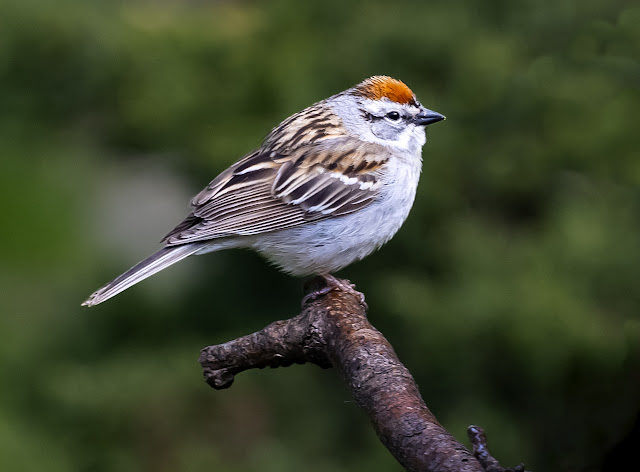I’ve had a birdfeeder in the back garden for years. I never paid a whole lot of attention to the little brown birds who were attracted to it. Occasional bright red cardinals were an exception, of course. But a silver lining to COVID was that I spent a lot of time in the garden in the last few years and became an avid bird watcher and photographer. I took all of the photographs in this post in my back yard.
I discovered that most of the birds were House Sparrows, the most successful bird species on the planet. I wrote a blog entry on the House Sparrow in May of last year.
 |
|
Males are quite striking, females more restrained, but also pretty if you look up close. |
A major problem when feeding birds is how NOT to feed squirrels instead. Squirrels eat a lot more than birds and can empty a bird feeder in minutes. They’re also incredibly smart and athletic, so they’re hard to outwit. For now this feeder is working for me.
 |
|
The bar that the sparrows are perched on is spring-loaded. The weight of a squirrel drops the bar and a shield that blocks off the bird seed. |
 |
| Red-breasted Nuthatch |
 |
| White-breasted Nuthatch |
 |
|
Spectacular male Cardinal. They particularly like showering when the sprinkler is on. |
 |
| More restrained and very beautiful female Cardinal. |
 |
| For a change, female Blue Jays are as brightly coloured as the males. |
 |
|
Blue Jays come for the peanuts in a special “wreath feeder”. The two baffles above the feeder have successfully defeated the squirrels ... for now. |
 |
|
Brown-Headed Cowbirds are interesting. Like Cuckoos, they lay their eggs in the nest of other species and outsource the raising of their chicks to the unsuspecting hosts. |
 |
|
Grackles have shown up occasionally. This female seems be yelling at her spouse for some unknown reason. Perhaps she didn’t like the lawn furniture, because they haven’t been back since. |
Perhaps the most exciting bird – and only once, so far – a Cooper’s
Hawk showed up and posed for a few minutes. I expect he was not here for the food,
but for those who were here for the food.
 |
| I used Photoshop to combine the front and back view of the same bird into one picture. |
Winter was a surprise to me. I had believed the common myth that you should stop feeding birds in Fall, because the availability of food might persuade them not to migrate in time, and then they’ll get stuck in the cold and might die. In fact, that’s untrue. Birds are far smarter than that. They know when they need to migrate based on the shortening daylight hours. They’re not affected by an abundance of food. More than that, I discovered that many bird species don’t migrate. I used to think that call of Cardinals in Spring was evidence that they had returned from their winter homes. But no, Cardinals are here for winter.
 |
|
Dark-eyed Juncos do presumably migrate, but only to “mild” Toronto. I never see them except in Winter. |
Woodpeckers also stay over winter. I get Downy and Hairy Woodpeckers. They’re almost the same, except for the size. In both species, the male and female are almost identical, except that the male has a prominent red spot on its head.
 |
|
Adding a bird bath to the garden also attracted more birds. Juvenile robins were particularly interested in splashing around. |
Capturing pictures of birds in flight has been a great motivator to explore some of the more complex functions of my camera. Shutter speeds of 1/2500 seconds, continuous shooting and focusing are really useful.
If you’re not already a bird-watcher, I hope this inspires you take an interest in the birds in your back yard.
Useful equipment:
- A squirrel-proof bird feeder.
- Binoculars. You don’t need (or want) high-powered one. Magnification of 7 or 8 is ideal (this is the first number in the specification of the binoculars. I’m using very small 8x25. Bigger 8x42 will give a brighter image.
- A bird recognition guide. This one works well for me
- The smartphone app Merlin, from the Cornell University Lab, is brilliant. By giving just a few details about a bird you’ve seen – location, size and colours – the app will show you the most likely candidates. It has recently been enhanced to give you amazingly accurate real-time identification of bird calls.
Happy birding.















2 comments:
Fabulous photos, Simon! I envy your birdwatching life list!
Thanks, Paula. Not actually a life list, just the birds I managed to get decent pictures of in my backyard. I've had glimpses of a few more in my back yard, but not photographed. I don't think the list is really uncommon. The key is: feed them and they will come.
Post a Comment